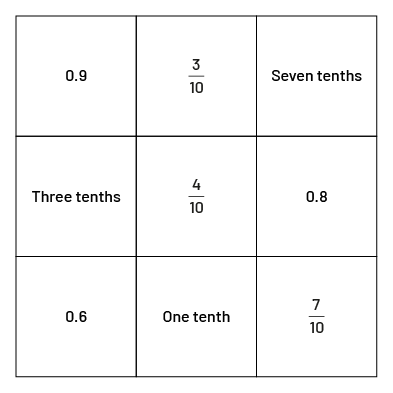B1.9 Describe relationships and show equivalences among fractions and decimal tenths, in various contexts.
Activity 1: The Clothesline
Write fractions, mixed numbers, whole numbers, and decimal numbers on flash cards. Place two cards on either end of a clothesline (or number line). Have a student randomly select a flash card and place it on the clothesline (or number line), paying attention to the order and space between the numbers. When the student places their card, they must justify their choice of location and answer any questions that may be asked. Continue the activity by inviting other students to take turns doing the same thing.

Source: translated from Guide d'enseignement efficace des mathématiques de la 4e à la 6e année, Numération et sens du nombre, Fascicule 3, Nombres décimaux et pourcentages, p. 159.
Activity 2: The Chocolate Bar
Share the following situation with students:
You have a chocolate bar and you want to share tenths of it equally with your friends. How can you distribute the tenths? How many friends can you share with?
Invite students to come up with various solutions using concrete or visual (semi-concrete) representations and to write, in fractions and decimal numbers, the portion of the chocolate bar shared.
Example

You can give \(\frac{2}{{10}}\) or \(\frac{1}{5}\) or 0.2 of the chocolate bar to 4 of your friends.

You can give \(\frac{1}{{10}}\) or 0.1 of the chocolate bar to 9 of your friends.

You can give \(\frac{5}{{10}}\) or 0.5 of the chocolate bar to 1 of your friends.
Activity 3: Decimal Number Bingo
Prepare cards with numbers from one tenth to nine tenths written on them with words, decimal notation, and fractional notation. Place the cards in a bag.
Ask students to fill in a \(3\; \times \;3\) grid with numbers from one tenth to nine tenths of their choice, written in either words, decimal, or fractional notation.
Example

Remove a card from the bag and read it to the students. Explain that if one of the three representations of this number is on their grid, they must cover it with a counter. If there is more than one representation of that number on their grid, they can cover only one of them. Explain that the game continues until a student has covered all the squares on their grid, at which point they win the game.
Source: translated from Guide d'enseignement efficace des mathématiques de la 4e à la 6e année, Numération et sens du nombre, Fascicule 3, Nombres décimaux et pourcentages, p. 144-145.
